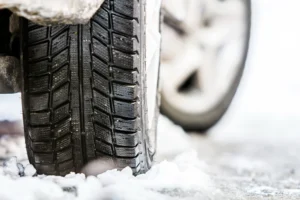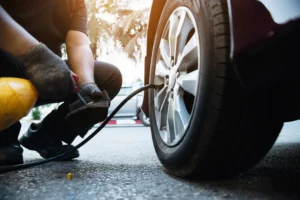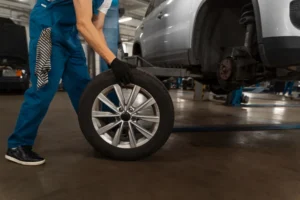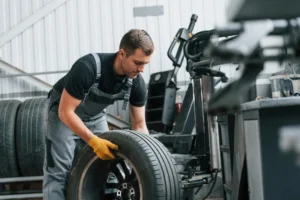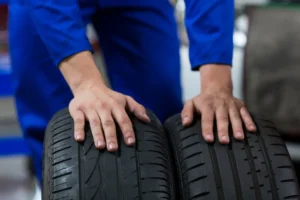Your tyres are the unsung heroes of your vehicle. They provide the grip, stability, and control that keep you safe on the road. Yet, because they wear down gradually, many drivers don’t realise their tyres need replacing until a serious problem occurs.
Knowing the warning signs can help you act early, avoiding costly repairs and, more importantly, preventing accidents. In this guide, we’ll cover the key indicators that tell you it’s time to invest in new tyres, and why acting promptly protects both your car and your safety.
The Legal Tread Depth Limit
In the UK, the law requires that tyres have a tread depth of at least 1.6mm across the central three-quarters of the tyre and around the entire circumference. Anything below this is illegal and dangerous. To put this into perspective, tyres with low tread significantly reduce traction, especially in wet conditions. Stopping distances can increase dramatically, making it harder to avoid accidents.
A simple way to check tread depth is with the “20p test.” Insert a 20p coin into the main tread grooves of your tyre. If you can see the coin’s outer rim, your tread is likely too low, and the tyre needs replacing. Alternatively, many tyres have tread wear indicators built in. These are small raised bars of rubber within the tread pattern that become flush with the surface when the tyre is worn.
Cracks, Cuts, or Bulges in the Sidewall
While tread is critical, tyre sidewalls also demand attention. Sidewalls are particularly vulnerable to kerb impact, potholes, and weathering. Over time, cracks may form due to exposure to sunlight, ozone, and fluctuating temperatures. These cracks weaken the tyre structure, making it more prone to blowouts.
Bulges, on the other hand, often result from internal damage to the tyre’s casing. If you spot a bulge, it indicates that the tyre’s inner layers are compromised. Driving on a tyre with a bulge is extremely risky — it could burst at any time. Cuts and abrasions caused by sharp objects can have similar effects. The rule of thumb: if the sidewall shows visible damage, the tyre should be replaced immediately.
Uneven Tyre Wear
Even wear across the surface of a tyre suggests everything is working properly. But uneven wear patterns tell a different story. There are several types of uneven wear:
- Edge wear: Often caused by underinflation, leading to too much pressure on the outer edges.
- Centre wear: Usually the result of overinflation, causing the tyre’s middle to wear faster.
- One-sided wear: Frequently linked to wheel alignment or suspension issues.
Uneven wear not only shortens the life of your tyres but also affects handling and increases fuel consumption. Checking for uneven wear can help you address underlying problems like alignment or inflation issues, preventing further damage.
Vibrations While Driving
A smooth ride is one of the hallmarks of well-maintained tyres. If your steering wheel vibrates or your vehicle shakes at certain speeds, it may indicate an issue with your tyres. Common causes include:
- Unbalanced tyres leading to uneven rotation.
- Damaged tyres with internal defects.
- Worn suspension parts exaggerating the effect of tyre irregularities.
Ignoring these vibrations can cause premature wear on tyres and damage to other components like wheel bearings or suspension. If you feel persistent vibrations, it’s wise to have your tyres inspected promptly.
Increased Stopping Distances
Your tyres play a vital role in how quickly your vehicle can come to a stop. If you’ve noticed your car takes longer to stop, even in normal conditions, worn tyres may be the culprit. Reduced tread depth means less grip, particularly on wet or icy roads. Hydroplaning becomes more likely, as shallow grooves cannot channel water effectively.
Stopping distances can be the difference between a near miss and a serious accident. If you notice your brakes are performing differently, don’t just assume it’s the brake system — check your tyres as well.
Strange Noises While Driving
Tyres in good condition should produce minimal road noise. If you hear unusual sounds — such as thumping, humming, or grinding — it may suggest issues like uneven wear, cupping, or damage to the internal structure of the tyre. While road surface and tread design influence noise levels, a sudden change in tyre sound often signals a problem that requires attention.
Age of the Tyres
Even if tyres appear fine to the eye, age can be a factor. Rubber degrades over time, becoming less flexible and more brittle. Most tyre manufacturers recommend replacing tyres every six to ten years, regardless of tread depth. Check the sidewall for the DOT code, which includes a four-digit number indicating the week and year of manufacture. For example, “2319” means the tyre was made in the 23rd week of 2019.
If your tyres are older than six years, consider replacing them even if they still have tread left. Ageing tyres may fail suddenly, especially under stress.
Frequent Loss of Pressure
Healthy tyres should maintain consistent air pressure. If you find yourself topping up a tyre regularly, it may have a slow puncture, a faulty valve, or a compromised bead seal. While some issues can be repaired, persistent pressure loss is often a sign it’s time for replacement. Driving on underinflated tyres generates heat, increases fuel consumption, and causes accelerated wear, making them both costly and unsafe.
Fuel Efficiency Dropping
If you’ve noticed you’re filling up at the pump more often without any changes to your driving habits, your tyres may be to blame. Worn or underinflated tyres increase rolling resistance, meaning your engine has to work harder. New tyres, properly fitted and balanced, can restore fuel efficiency and save you money over time.
Why Acting Quickly Matters
Ignoring the warning signs of tyre wear can have serious consequences. Tyres in poor condition increase the risk of accidents, lead to penalties for breaching legal tread requirements, and may cause additional wear on suspension and steering components. The cost of replacing tyres is far lower than the potential financial and safety consequences of an accident or roadside breakdown.
Conclusion
Your tyres are fundamental to your safety on the road. By looking out for signs like reduced tread depth, cracks, bulges, uneven wear, vibrations, strange noises, and pressure loss, you can catch problems early. Regular checks not only keep you compliant with the law but also extend tyre life, improve fuel economy, and enhance your driving experience.
If you notice any of these warning signs, don’t delay. Arrange for mobile tyre fitting or replacement to ensure your vehicle remains safe and roadworthy. Acting promptly keeps your journeys smooth, efficient, and most importantly, safe.
